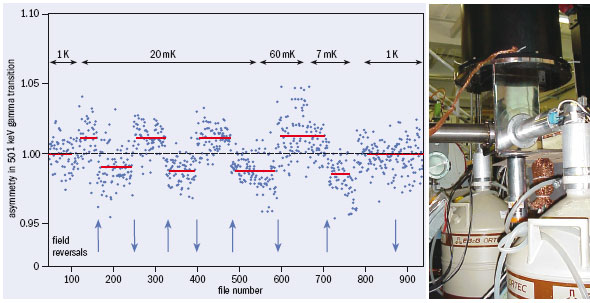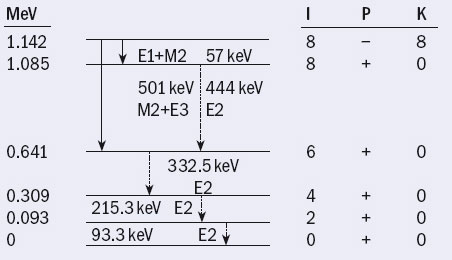Results from a recent measurement at CERN’s ISOLDE facility are a tribute to the announcement 50 years ago of the first observation of the non-conservation of parity.
It was 50 years ago last October that Tsung-Dao Lee and Chen Ning Yang suggested that the invariance under mirror reflection that we experience in everyday physical laws – parity symmetry – might be violated on the microscopic scale by the weak interaction (Lee and Yang 1956). They made this truly revolutionary suggestion to solve the so-called θ-τ puzzle, which involved two different decay modes of what seemed to be a single particle (now known as the K-meson) and which violated parity conservation. Lee and Yang formulated a description of the weak interaction that enabled parity to be violated, and were later awarded the Nobel prize for their theory.
Proving the theory
Just a few months later, in January 1957, Chien-Shiung Wu of Columbia University and collaborators Ernest Ambler, Raymond Hayward, Dale Hoppes and Ralph Hudson from the National Bureau of Standards in Washington announced that they had successfully confirmed the theory by observing parity non-conservation (PNC) in the beta-decay of a polarized sample of the radioactive 60Co nucleus (Wu et al. 1957). PNC has since become a cornerstone of the formulation of the weak interaction and the Standard Model of particle physics, even though its origin remains unexplained.

Fig. 2 (right). The dilution refrigerator NICOLE in the ISOLDE hall, with the beam line (to the left), cryostat and Ge detectors visible.
The experiment used a modified version of a facility at the Bureau of Standards in which the spin of all nuclei pointed in one direction, a feat that required cooling the nuclei in the presence of a magnetic field to a temperature of several millikelvin above absolute zero. Under these conditions, the nuclei decayed under the influence of the weak force and emitted beta particles (electrons) and antineutrinos. In fact, the antineutrinos could not be observed in this system, but the effect on the electrons was measurable. The team showed that, as suggested by the theory of Lee and Yang, the number of electrons emitted in one direction with respect to the nuclear spin direction was significantly greater than the number emitted in the opposite direction, clearly indicating that parity was violated. Had it been conserved, equal numbers of electrons would have been observed in both directions.
Parity violation is characteristic of the weak nuclear force, but the strong nuclear force and the electromagnetic force preserve parity. Since the 1950s, these three fundamental forces in nature have been combined in a single theory – the Standard Model. This model suggests that PNC can also manifest itself in processes that are dominated by the strong and electromagnetic interaction, via the weak interaction part in the nuclear Hamiltonian – but such effects are usually minute and very difficult to observe (Adelberger et al. 1985 and Desplanques et al. 1980).

In this article we will focus on measurements of PNC effects in bound nuclear systems, where parity mixing occurs between pairs of nuclear states of the same spin as a consequence of the weak part in the Hamiltonian. A PNC effect in a bound system can be written as:
PNCeffect ∝ |<HPNC>|K /ΔE
Here <HPNC> is the matrix element of the weak Hamiltonian, ΔE is the energy difference between the parity doublet levels and K is a model-dependent amplification factor, related to the ratio between the reduced matrix element of the “normal” gamma decay and the “abnormal” (PNC-enabled) matrix element of the same multipolarity. Table 1 lists several such cases, indicating values of <HPNC> and estimates of K for each transition.

Among these cases, the mixing of the levels with spin I = 8 in the 180mHf nucleus provides a unique opportunity to study PNC in the electromagnetic and strong sectors, owing to the very large amplification. This amplification, of around 109, arises from the details of the nuclear structure, such as the proximity of the 8+ and 8– levels to each other, and the very different structure of the 8– level with respect to the sequence of positive parity levels below, to which it decays (figure 3). In the early 1970s, Kenneth Krane and collaborators at the Los Alamos Scientific Laboratory succeeded in observing parity mixing in the decay of 180mHf, when they measured a left–right asymmetry of about 1% in the emission of the 501 keV gamma transition (Krane et al. 1971a and 1971b).
Revisiting the evidence
This observation has been the only clear-cut demonstration of this type of parity violation until now and, as such, a group of us felt that the case deserved revisiting using the modern techniques of radioactive beams provided by the ISOLDE facility at CERN. During an experiment in October 2005, we produced a beam of 180mHf nuclei in their isomeric (metastable) 8– level at ISOLDE and implanted it into a magnetized iron foil at around 20 mK inside the NICOLE low-temperature 3He – 4He dilution refrigerator (figure 2).

By detecting the 501 keV decay gamma-rays (figure 4) in two horizontal germanium detectors situated outside the NICOLE refrigerator, fore and aft (0° and 180°) of the polarization direction, we could determine the left–right asymmetry of the decay – a direct consequence, and a direct proof, of PNC. We used another detector, below the beam line at 90° to the axis of polarization, to monitor the 0°/90° ratio that provides a measure of the nuclear polarization and temperature.
The results we obtained show the parity-violating effect in the 501 keV gamma transition (figure 1) in close agreement with the previous experiments. Analysis yields an asymmetry of about 1% (Stone et al. 2007).
So the present experiment re-establishes the case of 180mHf as the prime example of PNC in bound nuclear systems, a fitting tribute, 50 years on, to the work of the pioneering scientists.
Further reading
E G Adelberger et al. 1985 Ann. Rev. Nucl. Part. Sci.35 501.
B Desplanques et al. 1980 Ann. Phys.124 449.
K S Krane et al. 1971a Phys. Rev. Lett.26 1579.
K S Krane et al. 1971b Phys. Rev. C4 1906.
T D Lee and C N Yang 1956 Phys. Rev.104 254.
J R Stone et al. 2007 to be published.
C S Wu et al. 1957 Phys. Rev.105 1413.





